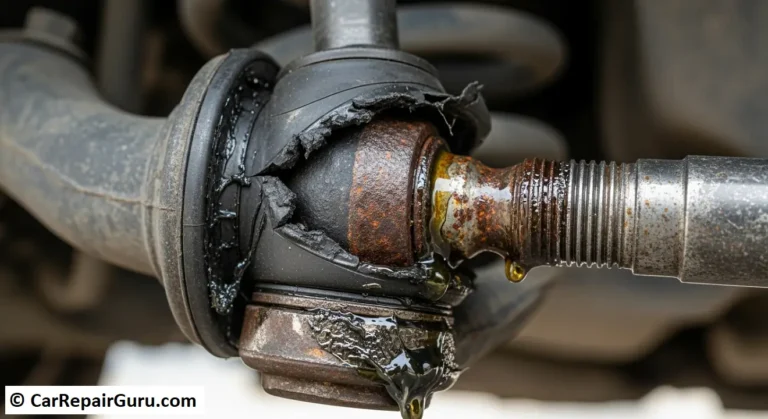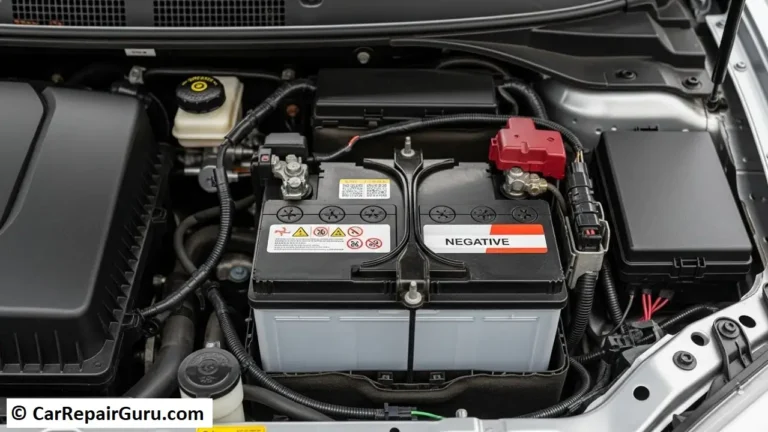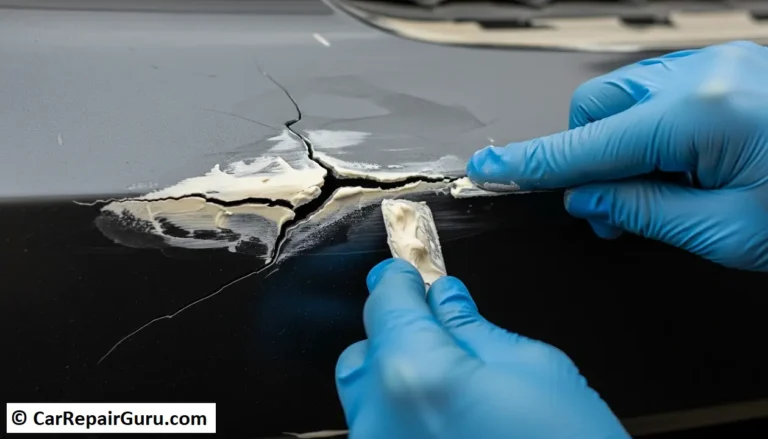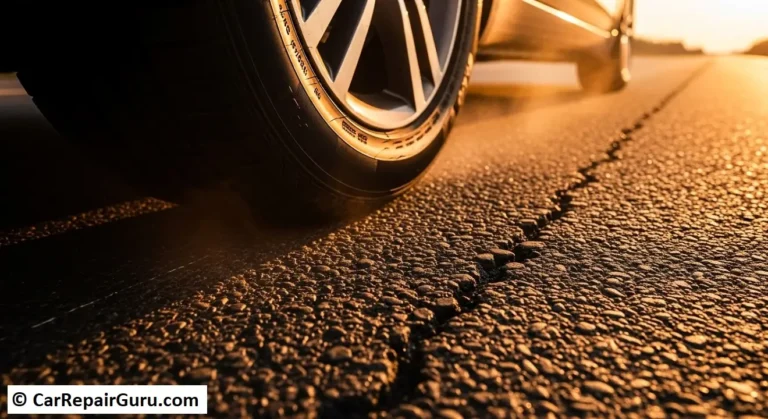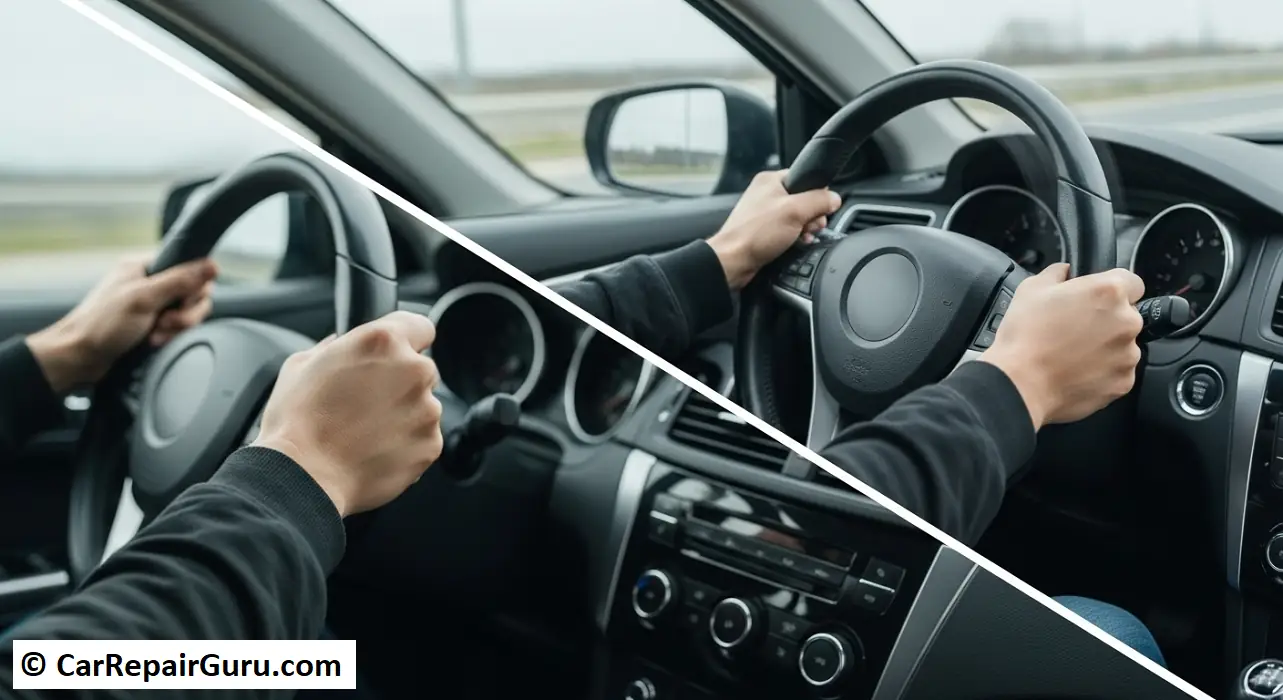
That split-second of unresponsiveness when you turn the wheel is more than just unnerving—it’s a critical warning from your car. Your steering system is your direct connection to the road, a complex network of components that translates your every move into precise control. It’s arguably one of the most important safety features your vehicle has.
When it works correctly, you don’t even think about it. But when it starts to fail, the signs can be subtle at first, then quickly escalate into dangerous situations. Ignoring these warnings can lead to not only expensive repairs but also a complete loss of vehicle control.
This guide will walk you through the five most common signs your steering system needs attention. Learning to recognize them will empower you to act fast, ensuring the safety of you and your passengers.
The 5 Key Warning Signs of a Failing Steering System
Think of these signs as your car trying to communicate with you. Let’s translate what it’s saying.
Sign #1 – Difficulty Turning the Steering Wheel
What You’ll Experience:
You feel like you’re suddenly wrestling with your car. The steering wheel feels unusually stiff, heavy, and requires a lot more muscle to turn than it used to. This is especially noticeable at low speeds, like when you’re navigating a parking lot or making a tight turn from a standstill. The smooth, easy glide you’re used to has been replaced by a workout. This problem of a car hard to turn is one of the most direct signs of a steering system issue.
Potential Causes:
This lack of “power” in your power steering is often caused by a few key culprits:
- Low Power Steering Fluid: This is the most common and simplest cause. The fluid is the lifeblood of the system, creating the hydraulic pressure that makes steering easy. If the level is low, the pump can’t do its job effectively.
- A Failing Power Steering Pump: The pump is the heart of the system. If it’s worn out or failing, it can’t generate enough pressure to assist your steering, even with adequate fluid. This is a classic bad power steering pump symptom.
- A Power Steering Fluid Leak: Low fluid is usually a symptom of a bigger problem—a leak. Hoses can become brittle and crack, or seals within the pump or steering rack can fail, allowing the fluid to escape.
- A Damaged Steering Rack: The steering rack is the component that physically turns the wheels. If it’s damaged or clogged internally, fluid can’t flow correctly, leading to stiff steering.
What to Do:
Safely pull over and, once the engine has cooled, check your power steering fluid reservoir (consult your owner’s manual for its location). If the level is below the “MIN” line, you have a leak somewhere that needs to be found and fixed. If the fluid level is fine, the issue is likely mechanical, pointing toward the pump or rack. In either case, it’s time to schedule a professional diagnosis.
Sign #2 – Unusual Noises When Turning or Steering

What You’ll Experience:
Your car shouldn’t sound like it’s complaining every time you make a turn. If you start hearing new and unusual sounds, pay close attention. These noises are specific clues that can help pinpoint the problem. Are you hearing a high-pitched whine, a deep groaning, a sharp squeal, or a heavy clunking noise when turning?
Potential Causes:
Each sound tells a different story about your steering system problems:
- Whining or Groaning: A persistent whine that gets louder as you turn the wheel is the classic calling card of a struggling power steering pump. This noise is often caused by low fluid levels, which forces the pump to work with air in the lines, or by the pump itself beginning to fail.
- Clunking or Popping: A “clunk” or “pop” felt and heard when you initiate or complete a turn often points to worn-out mechanical parts. The most likely culprits are worn tie rod ends or ball joints. These components connect your steering system to your wheels, and when they develop excessive play, they make a clunking noise as they shift under pressure.
- Squealing: A loud squeal, especially when you first start the car or during sharp turns, can be the serpentine belt. This belt drives several accessories, including the power steering pump. If it’s loose, old, or glazed, it will slip on the pulley, creating a high-pitched squeal.
What to Do:
Noises are never normal. They are a clear indication of wear and tear or a developing failure. Don’t turn up the radio to drown them out. A professional technician can lift your vehicle and identify the exact source of the sound, whether it’s a simple belt adjustment or a critical component replacement.
Sign #3 – A Vibrating or Shaking Steering Wheel
What You’ll Experience:
You’re driving down the road, and the steering wheel begins to vibrate or shake in your hands. This steering wheel shaking might be constant, or it could only appear at certain speeds, intensify when you accelerate, or happen only when you apply the brakes. This is not just an annoyance; it’s a sign of an imbalance somewhere in your vehicle’s front end.
Potential Causes:
While the most common cause is often simple, it can also indicate a more serious steering issue:
- Unbalanced Tires or Bad Alignment: This is the #1 reason for a vibrating steering wheel. If your tires are unevenly weighted or your wheels aren’t pointing in perfect unison, it will create vibrations that travel up the steering column.
- Worn Suspension Components: Worn ball joints, tie rod ends, or wheel bearings can introduce play into the front end. This looseness can manifest as a shake or shimmy in the steering wheel, as the wheels are no longer held rigidly in place.
- Brake Problems: If the shaking happens primarily or exclusively when you brake, you likely have warped brake rotors. The uneven surface of the rotor causes a pulsing vibration that you feel directly in the steering wheel.
- Damaged Axle: A bent or damaged axle from hitting a curb or pothole can also cause significant vibration.
What to Do:
Start with the most likely and affordable fix: have your wheels balanced and your alignment checked. If the problem persists after this service, it’s a strong indicator that the issue lies deeper within the steering or suspension system. A thorough inspection is necessary to ensure a critical component isn’t about to fail.
Sign #4 – Loose or “Sloppy” Steering
What You’ll Experience:
The precision is gone. There’s a noticeable “dead spot” in the center of the steering wheel’s range of motion. You have to turn it more than usual before the wheels actually begin to respond. The car may feel like it’s wandering or drifting in its lane, requiring constant small corrections to keep it straight. This sensation is often described as a loose steering wheel, and it feels like there’s a delay between your input and the car’s reaction.
Potential Causes:
This dangerous “slop” is almost always caused by worn-out parts creating excessive play in the steering linkage:
- Worn-Out Tie Rod Ends: This is a very common cause. Tie rods connect the steering rack to the wheels. When the joints at the ends wear out, they create a gap that must be taken up before the wheels will turn, resulting in that dead spot.
- Failing Steering Rack or Gearbox: Internal wear inside the steering rack or gearbox can also create excessive free play, leading to a vague and unresponsive steering feel.
- Worn Ball Joints: Similar to tie rods, worn ball joints in your suspension can contribute to a loose, wandering sensation as they allow for unwanted movement in the wheel assembly.
- Damaged Steering Column: Though less common, a problem within the steering column itself, like a worn U-joint, can also cause a feeling of looseness.
What to Do:
This is a major safety hazard. A loose steering system compromises your ability to make sudden, evasive maneuvers. Do not delay in getting this checked. A mechanic needs to put the car on a lift to physically inspect the steering and suspension components for play and identify which part needs replacement.
Sign #5 – Visible Power Steering Fluid Leak

What You’ll Experience:
This is the most straightforward sign of all. You notice a puddle of fluid under the front section of your car. Power steering fluid is typically thin and can be reddish, pinkish, or sometimes light brown in color. You might also spot wet, greasy grime built up on the power steering pump, the hoses, or the long metal steering rack located behind the engine.
Potential Causes:
A power steering fluid leak means a component has been breached. The fluid has to be escaping from somewhere:
- Cracked or Brittle Hoses: Over time, the rubber hoses that carry the high-pressure fluid can degrade, become brittle, and crack.
- Leaking Seals: The power steering pump and the steering rack both have multiple seals to keep the fluid contained. As these seals age, they can harden and fail, causing persistent leaks.
- Loose Connections: Sometimes, the fittings where hoses connect to the pump or rack can simply become loose, allowing fluid to seep out.
What to Do:
A fluid leak is a countdown to failure. Once enough fluid is lost, you will experience the “Difficulty Turning” symptom from Sign #1. If the system runs completely dry, the power steering pump will be destroyed from running without lubrication, turning a potentially simple hose repair into a much more expensive pump replacement. Find the source of the leak (or have a mechanic do it) and get it fixed promptly.
What Should You Do? Your Next Steps
Recognizing the signs is the first step. Taking action is the second. Steering problems are not “wait and see” issues; they are safety-critical and almost always get worse over time.
- DIY vs. Professional Help: While a confident car owner can check their power steering fluid, that’s where DIY work should end for most people. The steering system is complex and vital for safety. For any of the other symptoms—noises, looseness, vibrations, or leak diagnosis—a certified mechanic is your safest bet. They have the specialized tools and expertise to diagnose the root cause correctly and perform repairs that you can trust.
- Call to Action: Feeling any of these symptoms? Your safety is our number one priority. Don’t risk it on the road. Schedule a professional steering system inspection with our certified technicians today!
Stay in Control of Your Vehicle
Your car’s steering system is your direct link to the road, the primary tool you have to navigate safely. By learning to recognize the key warning signs—difficulty turning, strange noises, a shaking wheel, sloppy response, and visible leaks—you can address problems before they become catastrophic failures.
Paying attention to how your car feels and sounds is one of the most important things you can do as a responsible driver. It ensures you stay in confident control and keep every journey a safe one.
Don’t wait for a small issue to sideline you. Contact us today for a comprehensive vehicle inspection and peace of mind on the road!
FAQ About Steering Systems
What are the first signs of steering problems?
The most common signs include difficulty turning the wheel, strange noises like whining or clunking, and a vibrating or loose-feeling steering wheel. A reddish fluid leak under the front of the car is also a clear warning.
Why is my car so hard to turn all of a sudden?
A stiff steering wheel is most often caused by low power steering fluid from a leak or a failing power steering pump. The system lacks the hydraulic pressure needed to help you turn the wheels easily, especially at low speeds.
What does a bad power steering pump sound like?
A failing power steering pump typically makes a loud, constant whining or groaning noise. This sound will get noticeably louder and higher-pitched as you turn the steering wheel in either direction.
Can I just add power steering fluid if it’s low?
Yes, adding the correct fluid can be a temporary fix to make steering easier, but it does not solve the root problem. Since fluid doesn’t evaporate, a low level means you have a leak that must be professionally repaired.
Is it safe to drive with a loose steering wheel?
No, it is extremely unsafe. A loose or “sloppy” steering wheel indicates worn-out components like tie rods, which severely reduces your control and ability to react in an emergency. Have it inspected immediately.
